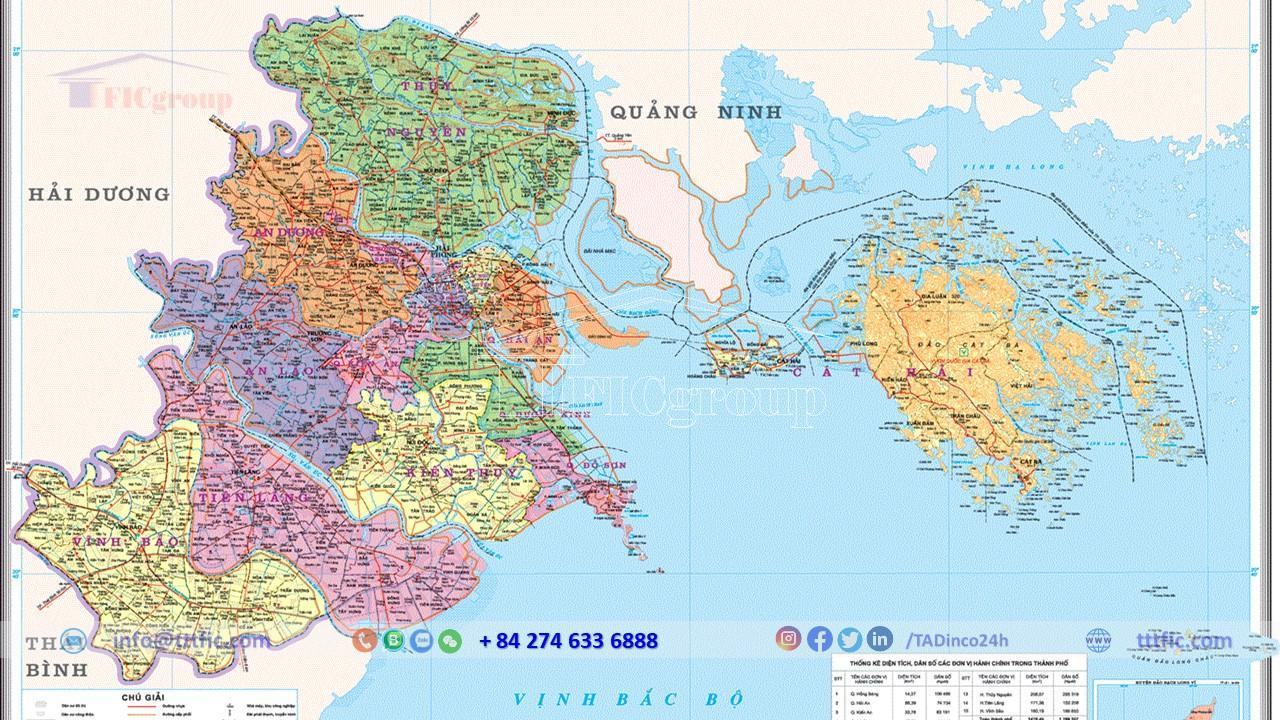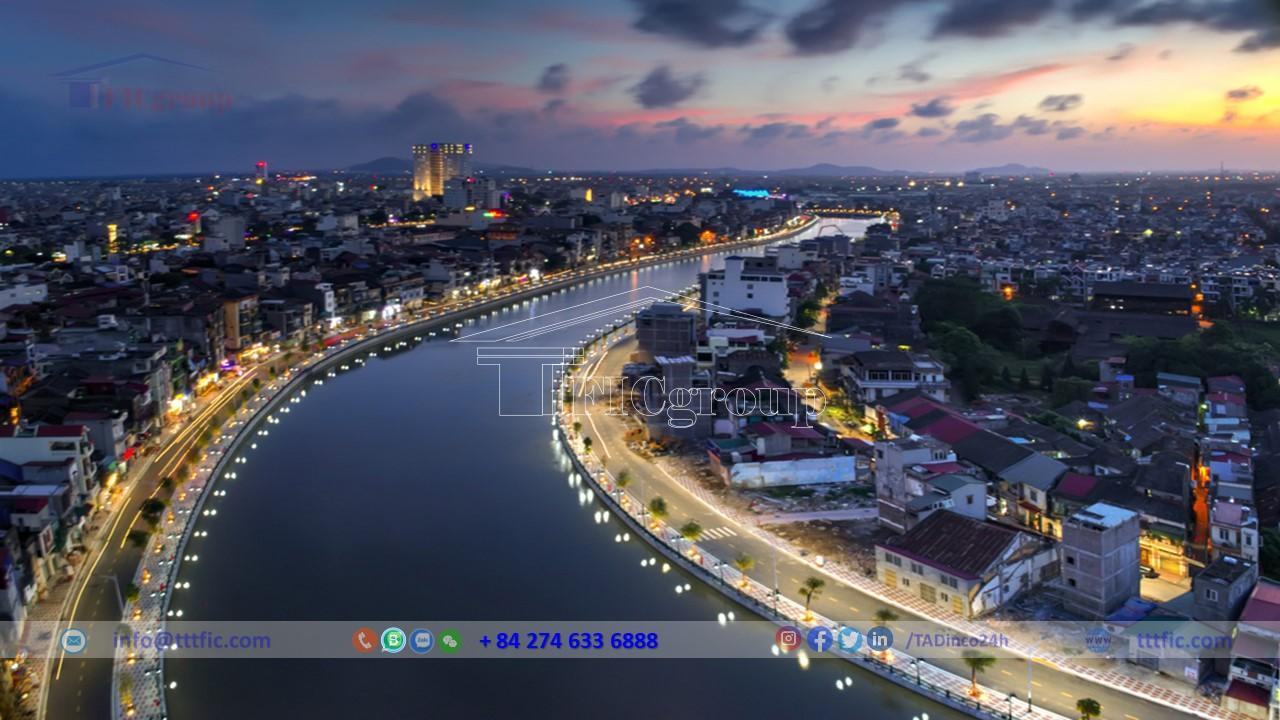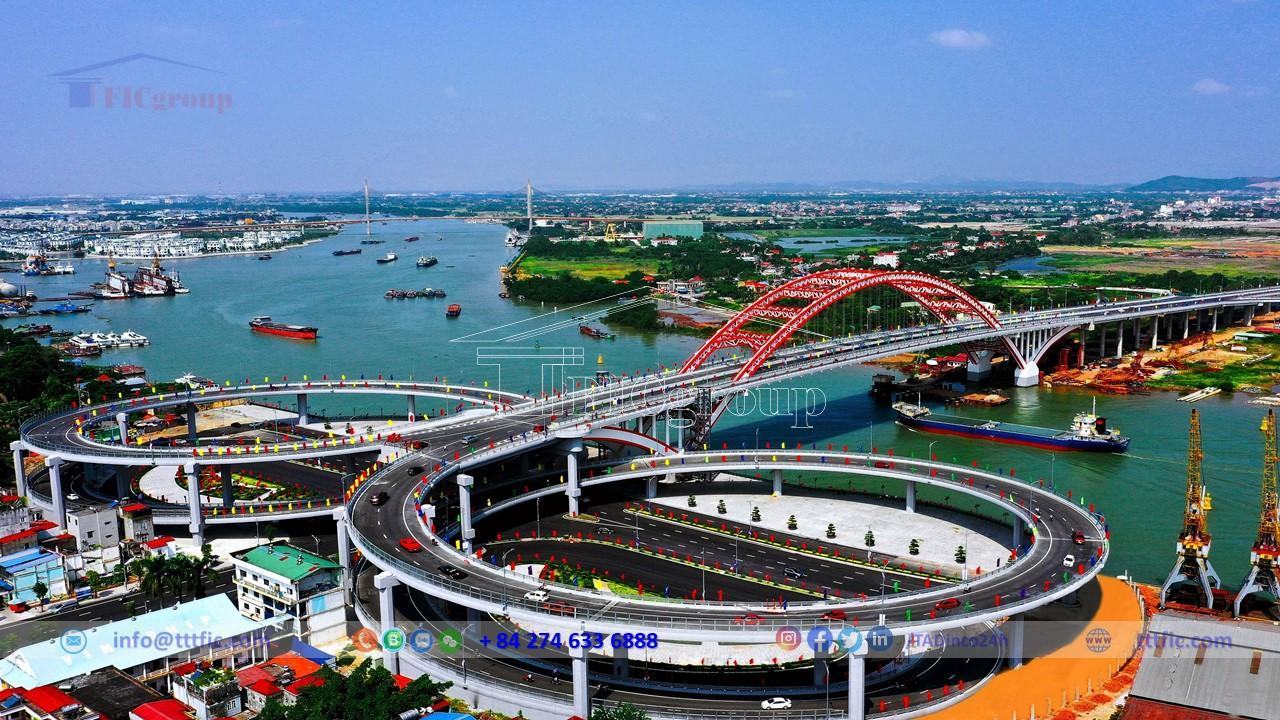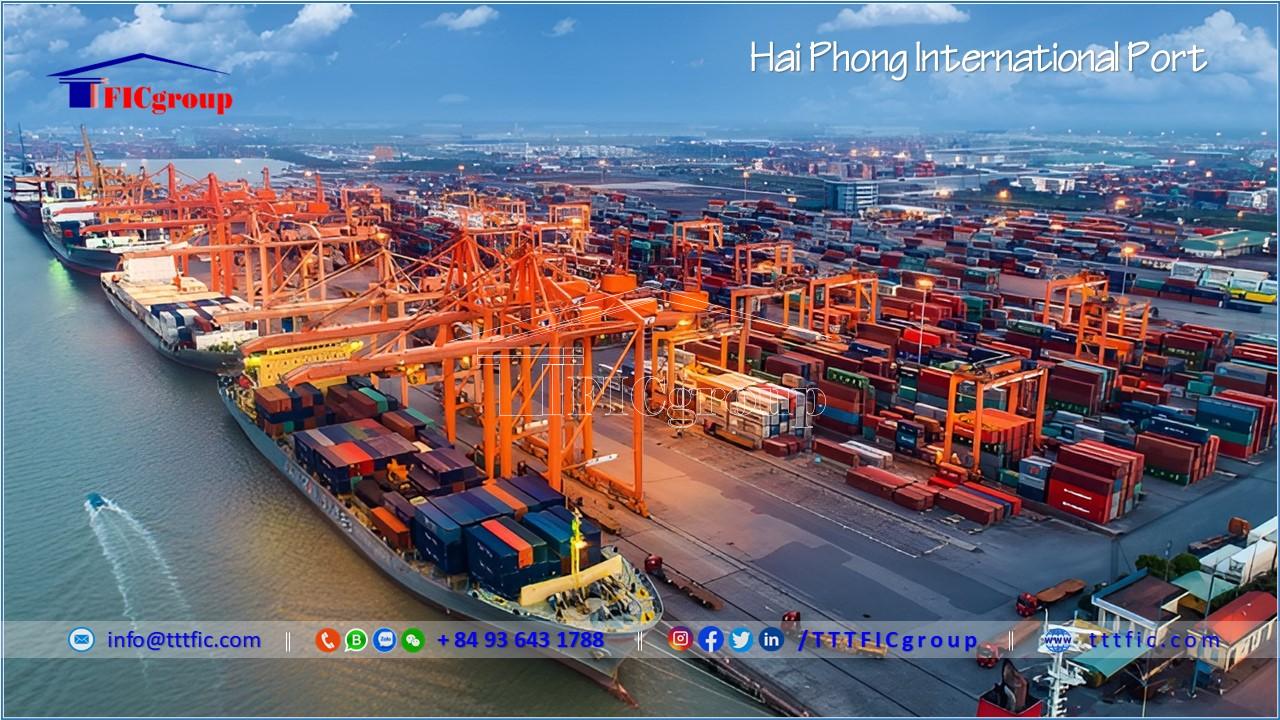
Trang Cat Industrial Park - Hai Phong
- Investor: Kinhbac City Group and Foxconn Group
- Price: 100 USD/m2
- Area: 790,79 Ha
Hai Phong is one of the five centrally-administered cities in Vietnam. It is a significant port city, industrial hub, and coastal port, also serving as the economic, cultural, healthcare, educational, scientific, commercial, and technological center in the Northern Coastal region of Vietnam. Hai Phong is currently classified as a Class I municipality, acting as a regional and national central city. Historically, Hai Phong was the location of the first electricity in Vietnam and Indochina.
Hai Phong’s origins trace back to prosperous coastal areas near present-day Quang Ninh. Geographically strategic, it sits 106 km east of Hanoi via National Highway 5A or the AH14 Trans-Asian Highway. Economically, socially, in terms of information technology, security, and defense, Hai Phong plays a crucial role in the Northern Coastal region and the nation, straddling two economic cooperation corridors: the Vietnam-China economic cooperation belt. Hai Phong serves as a major maritime transportation hub in the north, benefitting from its deep-water ports, fostering extensive maritime trade. It acts as a key growth driver for the Northern economic focal point. Furthermore, Hai Phong stands as an economic, scientific, and technological hub in the Northern Coastal region, being one of the two development centers in the Northern Key Economic Zone.
Hai Phong hosts several large industrial and commercial zones and service centers, tourism spots, educational institutions, healthcare facilities, and seafood processing plants in the Northern Coastal region of Vietnam. It significantly contributes to the tripartite growth of the Northern economic focal point, including Hanoi, Hai Phong, and Quang Ninh, outside Hanoi’s metropolitan planning. Moreover, Hai Phong serves as a vital node in the northern region, hosting the headquarters of the 3rd Military Region Command, the 1st Naval Region Command, and the Vietnamese Navy’s Armed Forces Service.
Hai Phong is often referred to as the “Port City.” The widespread cultivation of vibrant red flamboyant trees in the city has earned Hai Phong the nickname “City of Red Flamboyant Flowers.” Beyond its industrial identity, Hai Phong boasts substantial tourism potential. The city preserves architectural charm, blending traditional structures like temples and shrines with classical French architecture found in the old quarters. Moreover, Hai Phong is home to the Cat Ba Archipelago, a UNESCO World Biosphere Reserve, along with beaches and resorts in Do Son. The city also showcases unique cultural features, especially in its cuisine and traditional festivals.
Economically, Hai Phong’s Gross Regional Domestic Product (GRDP) in 2021 stood at 213,794.6 billion VND at current prices, ranking 5th out of 63 provinces and cities nationwide. The city’s economic growth rate reached 12.38%, leading the nation. The per capita GRDP was estimated at 7,300 USD in 2021, ranking 6th out of 63 provinces and cities. The preliminary data for 2019 indicates an average per capita income of 5,576,000 VND/month, ranking 7th out of 63 provinces and cities. The Party Committee’s goals for the 2020-2025 term include a minimum annual GRDP growth rate of 14.5% and a per capita GRDP of 11,800 USD in 2025, the highest among all provinces and cities in the country.

Hai Phong is a major city with a population of 2,028,514 as of April 1, 2019, ranking 7th in the country after Ho Chi Minh City, Hanoi, Thanh Hoa, Nghe An, Dong Nai, and Binh Duong. The city’s population density is 1,332 people/km², ranking after Ho Chi Minh City, Hanoi, Bac Ninh, and Hung Yen.
Hai Phong is located 70 km from Bach Long Vi Island (Hai Phong’s outer suburb), and 106 km east-southeast of Hanoi via National Highway 5.

Hai Phong consists of 15 administrative units, including 7 districts (Hong Bang, Le Chan, Ngo Quyen, Kien An, Hai An, Do Son, Duong Kinh) and 8 suburban districts (An Duong, An Lao, Bach Long Vi, Cat Hai, Kien Thuy, Tien Lang, Thuy Nguyen, Vinh Bao), with 217 administrative units at the commune, ward, and township levels.
Hai Phong’s population is 2,053,493, with an average population density of 1,315 people/km². The urban population is 932,547, accounting for 45.9%, with males comprising 49.45% and females 50.55%. The average annual population growth rate for the period 2011-2021 was 0.94%. The number of people aged 15 and over in the labor force is 1,075,700, accounting for 52.38% of the total population and 97.87% of the total labor force.

Hai Phong is a pivotal economic center in Northern Vietnam and the nation as a whole. During the French colonial period, it held the status of a first-tier city, equal in importance to Saigon and Hanoi. Towards the end of the 19th century, the French proposed transforming Hai Phong into the “economic capital” of Indochina.
Today, Hai Phong stands as one of Vietnam’s most significant economic hubs. Since 2005, it has consistently ranked among the top five provinces and cities contributing the most to the national budget, always holding the third position after Ho Chi Minh City and Hanoi. In 2015, the city’s total budget revenue reached 56,288 billion VND. In 2016, it rose to 62,640 billion VND, and in 2018, it reached 70,730.5 billion VND. In the Provincial Competitiveness Index (PCI) rankings of Vietnam in 2017, Hai Phong secured the 9th position out of 63 provinces and cities.
Hai Phong’s domestic revenue during the 2014-2017 term under Secretary Le Van Thanh saw remarkable growth, increasing by 2.4 times in just three years (from 2014 to 2017), exceeding the 3-year plan (Hai Phong aimed for domestic revenue of 20 trillion VND by 2020 but achieved 22 trillion VND in 2017). In 2018, Hai Phong’s domestic revenue reached 24,768 billion VND.
Amid the country’s deep and wide integration with historic trade agreements such as the Trans-Pacific Partnership (TPP) and the establishment of the ASEAN Economic Community, Hai Phong’s position as a significant investment destination for foreign investors in Vietnam has solidified. Several large FDI projects are concentrated in high-tech and low-pollution sectors, such as LG Electronics (1.5 billion USD), Bridgestone (1.2 billion USD), LG Display (1.5 billion USD), alongside other big names like Regina Miracle, Fuji Xerox, Kyocera, Nipro Pharma, and GE, demonstrating the city’s substantial appeal.
Notably, Hai Phong is the automotive capital of Vietnam. Vingroup’s VinFast Automotive Plant, covering 335 hectares with a total investment of 3.5 billion USD, aims to become a leading Made In Vietnam automobile brand. VinFast has invested and collaborated with major European automobile and component manufacturers, such as BMW, Siemens AG, Robert Bosch GmbH from Germany, Austria’s Magna Steyr, and Italy’s Pininfarina, making it one of Vietnam’s largest industrial projects, equipped with top-notch machinery, modern robots, and technology systems.
In addition to the effect from infrastructure development projects, such as the Hanoi-Hai Phong Expressway (reducing travel time to the capital to 1 hour and 30 minutes) and the Lach Huyen International Transshipment Port in Cat Hai, new industrial zones continue to be invested and expanded, including VSIP, Trang Due, Deep C II (Dinh Vu), Deep C III (Cat Hai), Nam Dinh Vu, contributing significantly to Hai Phong’s plan to become a “Green Port City.”
Prominent corporations like Vingroup, Himlam, Hilton, Nguyen Kim, Lotte, Hiep Phong Group (Hong Kong), Apage (Singapore), have brought numerous large-scale projects to Hai Phong in recent years. Vingroup has invested in a 1 billion USD eco-tourism project on Vu Yen Island (800 hectares), Vincom Le Thanh Tong, Vinhomes Imperia (a 45-story tower), Vinmec Hospital, Vinfast Automobile Manufacturing Plant on Cat Hai Island, Vin-Eco High-tech Agriculture Project, and the Waterfront urban area. Himlam developed a 5-star Hilton hotel on Tran Quang Khai Street, Ourcity Urban Area, Alibaba Group’s International Shopping Mall, Aeon Mall, Waterfront Urban Area, along with other projects like Hoa Phuong Island and Dragon Hill in Do Son, showcasing positive signs of the city’s service and tourism sector development.
Hai Phong is the largest import-export hub in Northern Vietnam, engaging in trade relations with over 40 countries and territories worldwide. The Hai Phong International Exhibition and Convention Center is currently the largest exhibition center in Vietnam. The city is striving to become one of the country’s largest commercial centers.
Scale: 153 hectares
Scale: Up to 3,400 hectares 2.1.
Scale: 541 hectares
Scale: 654 hectares
Scale: 520 hectares
Scale: 150 hectares
Scale: 196 hectares
Scale: 263.47 hectares
Scale: 401 hectares
Scale: Up to 790.79 hectares
Scale: Up to 1,600 hectares
Scale: 320 hectares
Scale: 1,329 hectares

With its strategic location as a vital transportation hub and the main gateway to the sea in Northern Vietnam, Hai Phong boasts a comprehensive transportation network, including roadways, railways, inland waterways, air travel, and seaports.
Hai Phong, strategically positioned as a gateway to the sea connecting the entire Northern region with the world, has historically been a major focus for port infrastructure development. In the late 19th and early 20th centuries, the French developed Hai Phong as a prominent commercial and financial center, especially renowned for its seaport in the Pacific region. By the early 20th century, Hai Phong’s port had established connections with many large ports in Southeast Asia, Asia, the Pacific, North America, the Indian Ocean, the Mediterranean, and the North Atlantic, making it a critical international trade hub.
Hai Phong’s port complex is a national-level integrated seaport cluster, second only to Ho Chi Minh City, and is currently undergoing government-driven upgrades. Situated along key maritime routes, linking Singapore to Hong Kong and other ports in East and Northeast Asia, Hai Phong Port is strategically positioned.
In addition to the main seaport, Hai Phong has over 35 other ports serving various functions, such as transporting liquid cargo (petrol, oil, and gas), shipbuilding docks, and ports for small river transport vessels with a load capacity of 1-2 tons (“mouse boats”) like the Vat Cach River Port and the So Dau River Port.
To accommodate the growing demands and enhance capacity, Hai Phong initiated the Lach Huyen International Transshipment Port project on Cat Hai Island, with a total investment of 1 billion USD. This future-ready port is designed to handle container ships and general cargo vessels weighing over 100,000 DWT and has been classified as an international gateway port (Type IA). Once operational, the Lach Huyen Container Superport will lead to the relocation of all inner-city river ports to Lach Huyen, transforming the urban landscape of the city.
Hai Phong is connected to Hanoi via the Hanoi-Hai Phong railway, constructed by the French between 1901 and June 16, 1902. This railway, spanning 102 km and nearly parallel to National Highway 5A, passes through Hai Phong, Hai Duong, Hung Yen, and Hanoi. Hai Phong Railway Station is the final passenger station on the Hanoi-Hai Phong railway. Along with Hue and Nha Trang railway stations, Hai Phong Railway Station retains its original French colonial architectural charm.
Hai Phong currently has one civilian airport, Cat Bi International Airport, the first airport constructed in the Northern region during the French colonial era. Initially developed for military purposes, the airport is now served by Vietnam Airlines and Jetstar Pacific Airlines, operating 42 flights per week between Hai Phong and Ho Chi Minh City. Vietnam Airlines recently inaugurated flights between Hai Phong and Da Nang, operating seven flights per week. The city is undertaking upgrades to Cat Bi Airport, aligning it with civilian airport standards (4E level) by 2015, allowing for aircraft such as B747 with limited loading capacity, B777-300, B777-200, and A321. The project includes the construction of a new runway, measuring 3,050m in length and 60m in width. The airport’s apron area will be expanded to accommodate eight aircraft. The renovation of the old runway into a taxiway, measuring 3,050m in length and 44m in width, is also part of the plan. The total investment for Phase 1 is 5 trillion VND. VietJet Air, Vietnam’s most valuable airline, has chosen Cat Bi International Airport as its hub. The airline has proposed the construction of a second terminal, planned for socialization, with groundbreaking scheduled for the fourth quarter of 2017.
The city also has plans to construct an international airport, Hai Phong International Airport, in Tien Lang district. This project is expected to become the largest airport in the Northern region, covering approximately 6,000 hectares, with a total estimated investment of over 8 billion USD, to be implemented in three phases until 2030.
Hai Phong is interconnected with other provinces and cities through major highways, including National Highway 5, National Highway 10, National Highway 37, and expressways like the Hanoi-Hai Phong Expressway, and the Quang Ninh-Hai Phong-Ninh Binh coastal expressway.
Being the drainage area for the entire lower reaches of the Thai Binh River, Hai Phong has a dense network of rivers. Consequently, constructing bridges is vital for the city.
Binh Bridge over the Cam River, connecting Hong Bang District and Thuy Nguyen District, considered one of the most beautiful bridges in Southeast Asia.
Lac Long Bridge over the Tam Bac River, located in Hong Bang District, noted for its scenic route.
Quay Bridge, also known as the railway bridge, spanning the Tam Bac River, a historic bridge constructed during the French colonial era.
Dinh Vu – Cat Hai Sea-Crossing Bridge, the longest sea-crossing bridge in Vietnam.
Bach Dang Bridge, part of the Hai Phong – Ha Long Expressway.
During the period from 2013 to 2018, Hai Phong set a record for constructing the highest number of bridges in Vietnam’s history, with 20 bridges, big and small, built and put into use. Among them, the Tan Vu – Lach Huyen Bridge stands out as the longest bridge in Vietnam. In 2016 and 2017, Hai Phong surprised everyone by completing some bridges, like the Nguyen Binh Khiem Overpass and the Dinh Vu – Thai Binh River Double Bridge, within just six months. Two bridges spanning the Thai Binh River, connecting Vinh Bao District and Tien Lang District, were finished in eight months. It is estimated that by 2030, Hai Phong will have 30 additional bridges, earning it the title of the “City of Bridges” in the Northern Coastal region. If Da Nang is the “City of Bridges” in Central Vietnam, known for its iconic bridges, Hai Phong will be known for its infrastructural significance, forming the most advanced logistics network in Northern Vietnam.

As a large city near the coast, Hai Phong plays a crucial role in the economic and tourism triangle of Hai Phong – Hanoi – Quang Ninh. Hai Phong boasts numerous attractions and high-quality tourist destinations of international standards, including 4-star resorts, casinos, the Do Son Golf Course, eco-resorts, and the largest man-made wave pool in Asia at Hon Dau. There are also resorts like Song Gia and Camela within the city, hot spring resorts in Tien Lang, and Cat Ba Island and Cat Ba Resort and Spa in the Cat Ba Archipelago. Foreign tourists, especially those from Europe, are particularly interested in Cat Ba Archipelago, a beautiful island with rich ecosystems, lush forests, and abundant marine life, complemented by high-quality hotels and restaurants.
In 2010, Hai Phong welcomed 4.2 million visitors, including 596,400 international tourists. In the first 7 months of 2011, the city received 2.516 million visitors, with 339,300 being international tourists. The total revenue from hotel, restaurant, and service activities exceeded 5.6 trillion VND, a 29.2% increase compared to the same period, with accommodation and travel services generating 908.4 billion VND, a 15% increase and 60.6% of the plan.
Today, due to the proper attention from the city and investors, Hai Phong’s tourism is thriving. The city’s tour products are becoming more diverse and appealing, featuring historical sites, traditional cultural festivals, and cultural heritage resources. Recent developments include the opening of a saltwater wave pool, the largest in Asia, at Hon Dau Resort in Do Son and the construction of a 5-star sail-shaped Pullman hotel on the artificial island of Hoa Phuong, representing Hai Phong’s future. Cat Ba is expanding its offerings with boat tours in the bay using ferries, speedboats, and kayaks. Moreover, there are ongoing efforts to develop diving programs at locations with coral reefs.
Despite achieving significant results and being considered an attractive destination, according to travel experts, Hai Phong’s tourism has not fully capitalized on its potential and existing advantages. The city has yet to fully exploit its geographical, natural, and human resources. Hai Phong’s tourism continues to undergo significant transformations to live up to its status as a major tourism center in the Northern region. Hai Phong was chosen as the center of the National Tourism Year 2013 in the Red River Delta. The opening ceremony was scheduled for May 12, 2013, at the Hai Phong Opera House Square.
Historical and Scenic Sites Do Son Beach Resort: Do Son is a seaside resort located 120 km from Hanoi and 20 km from downtown Hai Phong. It is a small peninsula surrounded by mountains, extending into the sea with fine sandy beaches. Historically, Do Son was a retreat for kings and officials, including the “solid octagonal house” of Bao Dai, the last king of the feudal dynasty of Vietnam. Today, Do Son is an ideal destination for day-trippers, offering good quality services at relatively affordable prices. Do Son also hosts the only casino in Vietnam and an international standard golf course.
Cat Ba Archipelago: Cat Ba is the largest island in the archipelago of 366 smaller islands in Lan Ha Bay (part of Ha Long Bay), 70 km from Hai Phong city. Cat Ba features clear blue beaches stretching along smooth white sandy shores and a diverse ecosystem of mangrove forests and tropical rainforests. Visitors to Cat Ba can explore Lan Ha Bay, Trung Trang Cave, Trung Son Cave, Phu Long Cave, Cat Ba National Park, and enjoy activities such as swimming, kayaking, and diving to savor the famous local seafood. Notably, Cat Ba is home to the golden-headed langur, an extremely rare primate species found only in Cat Ba. The Cat Ba Archipelago has been recognized by UNESCO as a biosphere reserve in the world, and it is proposed to be recognized as a world natural heritage site under biodiversity criteria, as part of the expanded Ha Long Bay.
Hon Dau: Hon Dau is a small island located 1 km southeast of Do Son. Its allure lies in its untouched and tranquil environment, a stark contrast to the bustling Do Son with its ancient giant banyan trees. The intact three-tiered vegetation system and the massive roots of trees deeply embedded in the earth make the island even more majestic. The untouched and tranquil atmosphere is accentuated by the Nam Hai Vuong Temple and the century-old lighthouse. For the locals, Hon Dau is a sacred place; they believe nothing can be taken from the island, not even a rock or a leaf. Thus, for hundreds of years, Hon Dau has maintained its pristine grandeur.
Other Notable Sites: Trang Kenh, Elephant Mountain Famous Temples and Pagodas Red Pagoda – A temple with unique and sacred architecture in Hai Phong Nghè Temple (dedicated to Lady Le Chan – the founder of modern-day Hai Phong) Cao Linh Pagoda Tam Ki Temple (dedicated to General Quan – Third son’s relief minister) Thirteen Root Banyan Tree, Tien Nga Pagoda, Cross Flower Garden (dedicated to Lady Năm Phương – Vu Quoc Quyen Hoa princess – the protector of the nation, considered a spiritual symbol of Hai Phong) Tu Luong Xam, Hai An District (also known as Ngo Quyen Temple – dedicated to Ngo Quyen, the king who defeated the Southern Han army on the Bach Dang River in 938. This is a national historical relic and the location of the largest statue of Ngo Quyen in Hai Phong) Long Son Temple (also known as Dragon Stream Temple in Do Son – dedicated to Chief Nine-Tail Fox) Van Ngang Temple – Do Son (dedicated to Chief Delegate Relief Community) Hang Kênh Pagoda (on Chua Hang Street), Red Pagoda, Pho Chieu Pagoda, Ve Pagoda, An Duong Pagoda… Commemorative Area for Mac Dynasty Kings in Ngu Doan Commune, Kien Thuy.

Hai Phong City is an ideal destination for investors, offering a range of attractive incentives. The government and local authorities have established favorable tax policies, reduced land prices, and provided financial support for investment projects. Particularly, investors in Hai Phong enjoy low tax rates, reducing financial burdens and increasing profits.
Additionally, the city provides a stable and secure investment environment with modern infrastructure and comprehensive support services. Policies supporting high-quality workforce training create favorable conditions for finding skilled labor, meeting the needs of businesses.
Hai Phong also focuses on supporting environmentally friendly and high-tech projects. These preferential policies not only help investors minimize environmental impact but also enhance the reputation and credibility of businesses in the international market.
In summary, with tax benefits, financial support, and an ideal investment environment, Hai Phong is a destination full of potential for both domestic and international investors, supporting the sustainable development of businesses.
Hai Phong, a majestic city located on the northern coast of Vietnam, is renowned for its strategic geographical position and thriving economy. With deep-water ports, Hai Phong is a crucial transportation hub, facilitating seamless import-export activities and international economic cooperation.
The city is also a leading industrial and technological center, attracting investments from large corporations and innovative enterprises. The development of industrial zones and research centers provides employment opportunities for the locals and creates a supportive environment for local and international businesses.
Hai Phong is not only known for its robust economy but also for its natural beauty and unique cultural heritage. Gentle beaches, lush green parks, and historical landmarks like Cau Son and Do Son make the city an attractive destination for tourists and nature enthusiasts.
In summary, Hai Phong is not just a powerful economic center but also an excellent investment and tourism destination, offering a diverse range of opportunities and experiences for residents and visitors alike.
Hai Phong, a maritime economic hub strategically located on the northern coast of Vietnam, has become a magnet for numerous domestic and international investors. With 14 Industrial Zones (IZs) covering a total area of 6,144 hectares, in addition to the Dinh Vu – Cat Hai Economic Zone (22,540 hectares), identified as a multi-industry and multi-sector maritime economic center in the northern coastal region and the nation, Hai Phong has attracted over 1,000 Foreign Direct Investment (FDI) projects with a total investment of up to USD 29.3 billion.
Emphasizing investment quality, statistics show that each new project within the IZs and Economic Zones of Hai Phong has an average capital of USD 28 million, 1.4 times higher than the national average and 6.3 times higher than projects outside the IZs and Economic Zones. Investors are shifting from broad investments to deeper investments, focusing on high-tech production sectors and projects that are environmentally friendly and energy-efficient.
Hai Phong has attracted leading global corporations such as Vinfast, LG (South Korea), Bridgestone, and many other multinational conglomerates. The manufacturing sector, particularly in automobiles and machinery, accounts for 34% of the total investment, followed by electronics (30%), logistics and construction (14%), textile and leather footwear (5%), and mechanical engineering (4%).
With these favorable factors, Hai Phong is not only a strong magnet for investments but also an ideal destination for investors seeking sustainable business opportunities and development.
————————————
Team Marketing
Tel: + 84 274 633 6888
Email: info@tttfic.com
Phone: + 84 916 974488
IG/Twitter/LinkedIn/Trang: /TTTFICGroup
Table of contents











